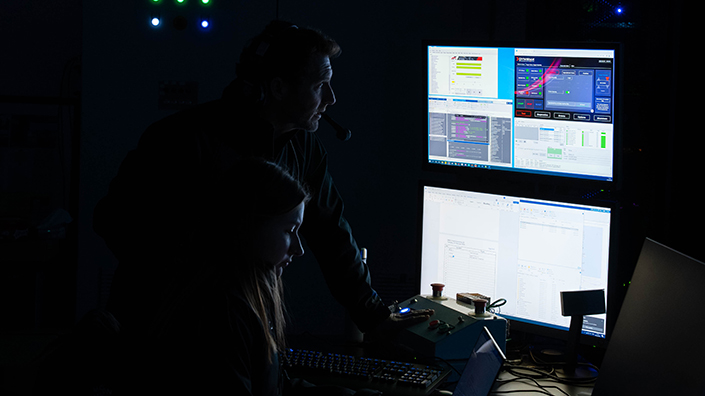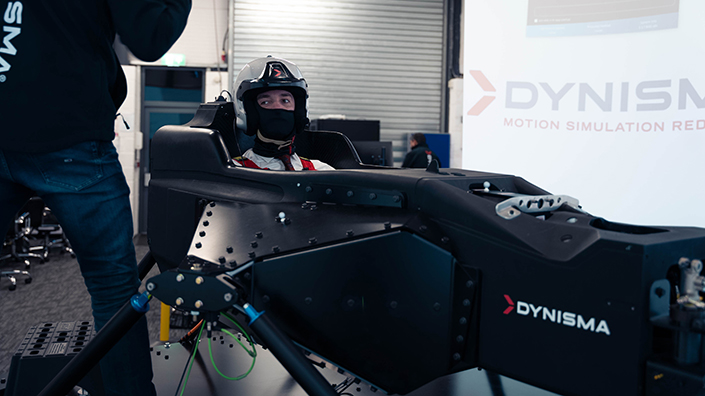That, of course, is a stupid thing to do at the wheel of a 350km/h-plus racing machine. I soon find out as I approach corner 15 too quickly, oversteer in a vain attempt to maintain control, and ride way too much of the kerb at the apex. There is a sickening jolt as the right wheel jumps up, before freezing in place as the car comes to a complete stop hanging in the air.
Thankfully I emerge from the incident completely unscathed, as I am in fact in the DMG-1 motion simulator at Dynisma, in a small industrial estate near Bristol. The crash was the first time that the drive did not feel completely real – probably for the best, given the potential real-life consequences of such a mistake.
Sitting in the cockpit, which is surrounded by a wrap-around projection screen and mounted on six servo actuators, I have been trying to keep mental notes of how the simulator feels, how its mechanical and visual parts generate the feeling of movement and speed. This is quite a challenge, as it simply feels so natural that you can drive a couple of laps without really realising what is happening – the accurate replications of the persistent rumble of the engine, the small, high-frequency bumps from the track surface, the larger movements and intense pressure from the steering wheel as I swing through corners.
Switching from the dramatic curves of Spa to a simulation of the genteel countryside in Gaydon, near Aston Martin’s headquarters, the difference in road surface and suspension is immediately evident. The simulated car, similar to a Volkswagen Golf, bounces around on the subtle bumps and dimples in a much looser, more comfortable way – until, that is, I start to relax into the ride again, and vastly overestimate the correct speed for a rural railway bridge.
High-frequency motion
It is all too easy to get swept up in the simple fun of using Dynisma’s technology, but the advanced engineering behind what has been described as the “world’s best simulator” is the reason I am here.
All of the company’s products have a central aim – to replicate the feeling of driving a particular car, with its own wheels, suspension, engine, aerodynamics and other characteristics, on a particular road surface. Designed for both motorsport and automotive manufacturer markets, it achieves this from the ground up with millimetre-resolution Lidar scans of roads and tracks. Software takes that data, and information about the simulated vehicle, and translates that through the hardware to the driver.
The shifting servo actuators provide high-frequency motion, while a set of three ‘large excursion motion generators’ underneath provide horizontal movements (yaw, surge and sway) to increase the immersion and boost the accuracy of the vehicle’s dynamic movement. The DMG-1 has maximum translational velocity of 1.5m/s, and rotational velocity of over 60°/s.

The carbon composite structures, which offer high stiffness and strength with low weight, and the six- or nine-degree of freedom Direct Drive technology, without traditional performance-limiting mechanisms such as ball screws or gearboxes, play a key role in what Dynisma says sets it apart from competitors – high frequency movements, and very low latency.
“Many other motion simulators are derived from technology that is used in flight simulation. Flight simulation is a very slow and low-frequency activity – you’re doing banked turns, you’re holding a steady state. In contrast, driving simulation is very much more about high frequencies, because you’re rigidly connected to the ground in some way,” says chief engineer and CEO Ash Warne, speaking during the visit in February.
“Simulators that are based on the similar technology that’s used in flight simulators are unable to render these higher frequencies, and the subtle movements. They’re much better suited to doing slow, sustained movements, rather than an ever-changing set of vibrations.”
It was that gap in the market that inspired Warne to found Dynisma four years ago, building a first device for the Ferrari F1 team in 2021.
Other devices have a latency – delay between input and response – of 20-50ms, compared to 3-4ms in Dynisma simulators. Typical bandwidth is 15-40Hz, while Dynisma offers 55-100Hz.
Essentially, this means the platforms provide more information to drivers, quicker, making the ride feel much more realistic and providing a deeper base of knowledge to influence vehicle development and refinement.
“Every other platform I have tried has an underlying mechanical feel,” said Darren Turner, Aston Martin factory driver and three-times Le Mans winner, in a Dynisma testimonial. “The DMG design has removed this issue and gives us a very natural and authentic ride quality.”
Push to the limit
Automotive engineering is saturated with data. Given the reams of information from virtual tests, wind tunnels, computational fluid dynamics (CFD), and the wealth of knowledge from previous vehicles, why is there still such a focus on what a car feels like to drive?
It depends on the application, says Warne, who has more than 15 years’ experience in simulator engineering, leadership and operational roles at McLaren, Ferrari F1 and Dynisma.
In motorsport, drivers need to know how to control the car, and to test how it responds to different tracks. Some combinations of vehicle dynamics might feel worse than others, so the simulator lets teams test them before race weekend. And drivers can push the simulated car to its limit, without fear of real-world accidents.
“Every aspect” of race performance can be improved, the company claims – from vehicle engineering and set-up optimisation to energy management and driver performance. Simulation also means tests can be done earlier in the process, providing repeatable results without real-world variability from weather or other factors.
Eliminating prototypes
Doing tests earlier in the process is a key part of Dynisma’s aim to cut down development time and ultimately ‘eliminate’ prototypes for automotive manufacturers.
“The purpose of carrying out development in simulation is in order to reduce the product development time, to bring the product to market faster and to reduce the cost of that by making fewer test articles, by doing all of the testing in simulation and then committing to a design that then goes straight on a test car,” says Warne.
“Most cars are developed with tens of prototypes, which have enormous costs associated with them. The aim is to continuously reduce that.”
The DMG simulators also give designers and engineers a novel perspective – as well as designing features and testing them in a simulator, teams can reverse the process by targeting certain characteristics in the simulator, then designing the component or system to meet the desired characteristic.

Aims might include increased comfort for passengers, or more responsive control for drivers.
“The requirements of a sports car and an executive car are quite different,” says Warne. “On the one hand you want the sports car to be relatively stiffly sprung, so the car is reactive and you can feel what it is doing. On the other hand, you also want it to be comfortable, you don’t want your teeth to be shaken out. There are compromises that can be made.”
In those premium vehicle markets, companies might define their brand and their ‘DNA’ through how they feel to drive.
“Manufacturers used to do this through the powertrain,” says Warne. “Different engine configurations give different characteristics, and they would tune them in different ways. The torque curves might be adapted to give a particular feel.
“But now, due to electrification, they no longer have that as a set of knobs to play with, to dial in the feeling for their car. It’s very much more focused on the chassis dynamics instead, which is where the motion is particularly important, and where our technology can be really valuable.”
Shock impulse
Already challenged by electrification, the conventional ideas of desirable car characteristics will face an even bigger overhaul as manufacturers include increasing levels of autonomy in their cars.
“With vehicles becoming just devices that ‘get you from A to B’ you might want to carry on working throughout that journey, or you might want to watch telly,” says Warne. “You’d much rather forget you’re in a vehicle at all, you certainly don’t want to feel the potholes in the road.”
Manufacturers might therefore put much more focus on eliminating unwanted bouncing and the ‘shock impulses’ that happen as you drive along the road, something that Dynisma’s simulators can help refine. The devices could also be used to test software updates for autonomous vehicles, the ‘driver’ in the simulator becoming more of a passenger.
Infinite yaw
With a workforce of 50 people, export level of 80% and “significant” turnover in the double-digit million pounds according to Warne, the company is already planning to expand after just four years. It is opening up a new site in Bristol, 10-times bigger than its headquarters, where it will demonstrate its technology and build four small and one large simulator at a time. It plans to ship five this year, and aims for double figures annually soon.
The company’s larger simulators increase the possible movements. These include infinite yaw on the DMG-360, making simulated ‘doughnuts’ and roundabouts a possibility, and side-to-side and back-to-front slides of up to 5m on the DMG-360XY for one-to-one manoeuvres such as lane changes.

Managers are confident that the market will grow in the coming years.
“Once a customer has a simulator they find ever more uses for it,” says Warne. “Nobody really has a simulator that isn’t fully utilised within a large business, because there are so many use cases that you can address. In a typical OEM, the vehicle dynamics department might buy the simulator, then the NVH (noise, vibration, harshness) department gets wind of it and says ‘Well we could use this for this’, the ride department does that with it, the vehicle dynamics department does something else, and then things like occupant monitoring for safety, for autonomy, all of these different use cases come about.”
In addition to being useful, the simulators are also a lot of fun – and that is not lost on the team at Dynisma.
“Anywhere there’s a person sat on a motion simulator, whether that’s in training, simulation, entertainment, VR, we see our technology has applications there,” says Warne. “While our first target markets are automotive simulation and motorsport, we’ve got plans to keep scaling the business to address these other markets in the future.”
Want the best engineering stories delivered straight to your inbox? The Professional Engineering newsletter gives you vital updates on the most cutting-edge engineering and exciting new job opportunities. To sign up, click here.
Content published by Professional Engineering does not necessarily represent the views of the Institution of Mechanical Engineers.